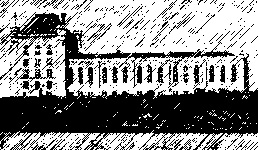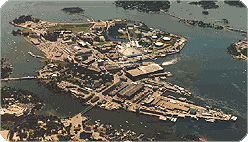An Inventory of Papers in Syracuse University Libraries© Organization Records
[*NYCHS Webmaster Note:
. . . .
All government, fraternal, social and institutional records, are located within this group. The materials include agendas, constitutions and by-laws, directives, membership lists, memoranda, minutes, reports, printed materials and scrapbooks. The records of prisons and prison societies are filed separately at the end of this group.
General
All government, fraternal social and institutional records other than prison records are located in this section
As with other organization records, these papers are supplemented by letters in the correspondence section, journals in the writings section, miscellaneous items in the financial records group and photographs located under memorabilia.
Sitting on an island on the Maine side of the Piscataqua River that separates Maine and New Hampshire, the shipyard base complex once included the naval prison, but that closed in 1974. The shipyard still remains an active Navy facility that repairs, overhauls and maintains Navy ships, including nuclear-powered submarines.
A current aerial view (below) found on the web site for the Navy base conveys its vastness and complexity. The former prison's structure is still pointed out to tourists taking sight-seeing cruises on the river. It is situated on a section of the island that juts out into the river in such a way that, from some angles at least, make it appear as if on an island of its own. For this reason some called it the Alcatraz of the East.
In June, 1999, the Navy executed a lease of the former Naval Prison at the Portsmouth Naval Shipyard to Seavey Island LLC, a local company marketing and developing business computer systems. Political leaders hailed the "outleasing" of such unutilized facilities as a way to kept the Portsmouth Naval Shipyard's maintenance costs down while preserving its mission . . . and the jobs it generates.
[Image selection & caption by NYCHS webmaster] New York State records were accumulated by Thomas Mott Osborne and his son, Lithgow. They served in elected and appointed office between 1903 and 1942. Among the papers are records of the state commissions on crime, prisons, and public utilities, the departments of conservation and correction, and the New York National Guard.
There is an extensive file which chronicles municipal government in Auburn, N.Y., where David Munson Osborne, Thomas Mott Osborne and Charles Devens Osborne --father, son and grandson -- were elected to the office of mayor. They include charter revision, police and fire protection, municipal finance, street railways and the water board.
Among the political, social, fraternal, charitable and educational institutions represented are
Prisons
Photographs
Nine albums and one box of glass negatives are located at the end of this section. . . .
|
| The Osborne Family Inventory text 1971 by Syracuse University Libraries |


